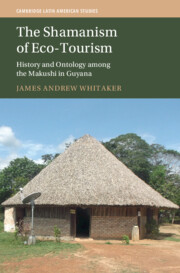Refine search
Actions for selected content:
9 results
2 - Eco-Tourism and Development in Surama Village
-
- Book:
- The Shamanism of Eco-Tourism
- Published online:
- 30 January 2025
- Print publication:
- 06 February 2025, pp 38-60
-
- Chapter
- Export citation
7 - Becoming the Other
-
- Book:
- The Shamanism of Eco-Tourism
- Published online:
- 30 January 2025
- Print publication:
- 06 February 2025, pp 146-168
-
- Chapter
- Export citation
Afterword
-
- Book:
- The Shamanism of Eco-Tourism
- Published online:
- 30 January 2025
- Print publication:
- 06 February 2025, pp 169-180
-
- Chapter
- Export citation
6 - Tourists as Shamanic Spirits
-
- Book:
- The Shamanism of Eco-Tourism
- Published online:
- 30 January 2025
- Print publication:
- 06 February 2025, pp 125-145
-
- Chapter
- Export citation
5 - Spirits in the Landscape
-
- Book:
- The Shamanism of Eco-Tourism
- Published online:
- 30 January 2025
- Print publication:
- 06 February 2025, pp 104-124
-
- Chapter
- Export citation
1 - Fetching the Outside among the Makushi
-
- Book:
- The Shamanism of Eco-Tourism
- Published online:
- 30 January 2025
- Print publication:
- 06 February 2025, pp 15-37
-
- Chapter
- Export citation
4 - Transformation and Otherness
-
- Book:
- The Shamanism of Eco-Tourism
- Published online:
- 30 January 2025
- Print publication:
- 06 February 2025, pp 82-103
-
- Chapter
- Export citation

The Shamanism of Eco-Tourism
- History and Ontology among the Makushi in Guyana
-
- Published online:
- 30 January 2025
- Print publication:
- 06 February 2025
10 - Local Power Relationships, Community Dynamics, and Stakeholders
- from Part II - Practical Issues
-
-
- Book:
- Revitalizing Endangered Languages
- Published online:
- 22 April 2021
- Print publication:
- 29 April 2021, pp 156-164
-
- Chapter
-
- You have access
- Open access
- HTML
- Export citation
